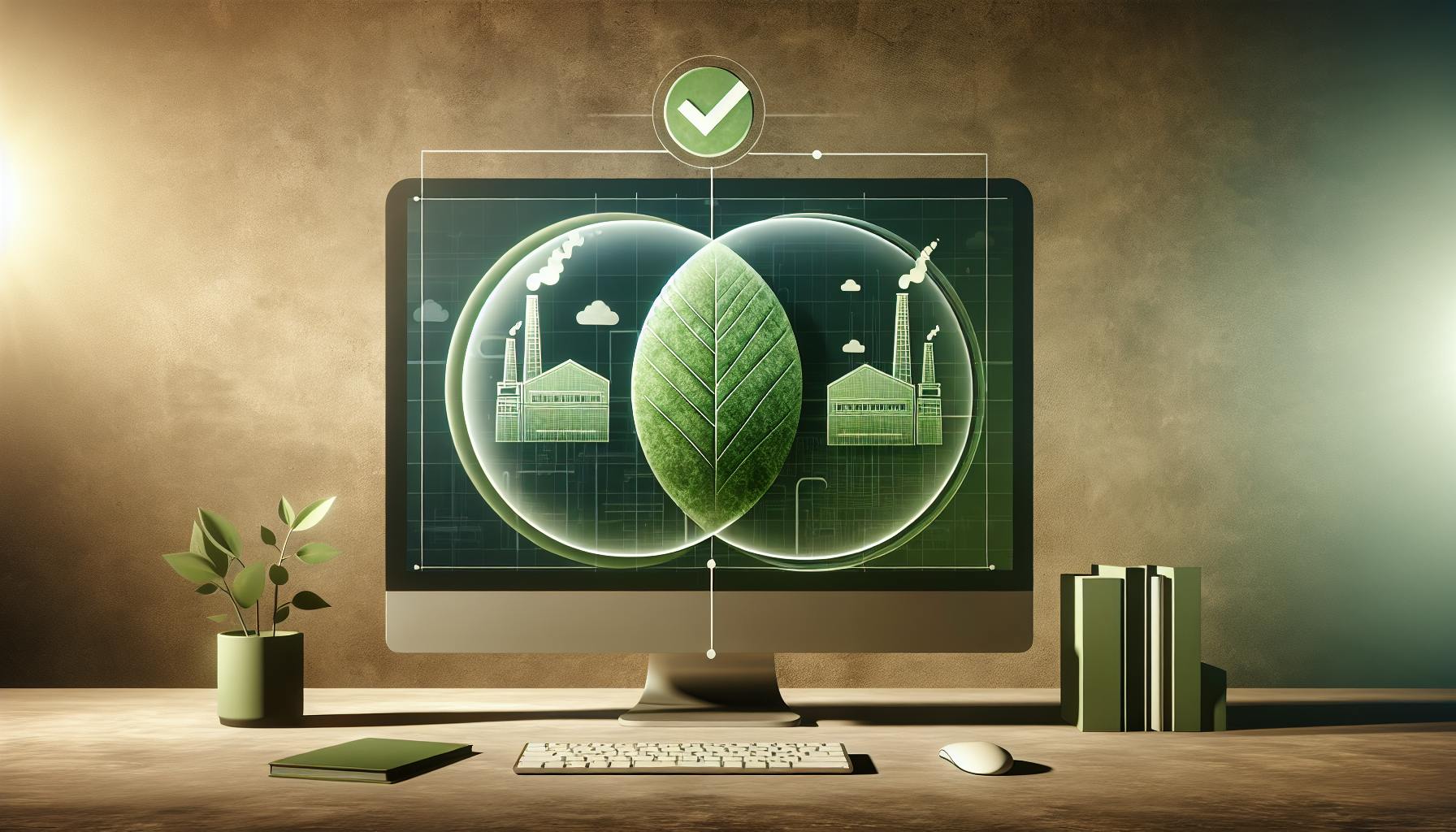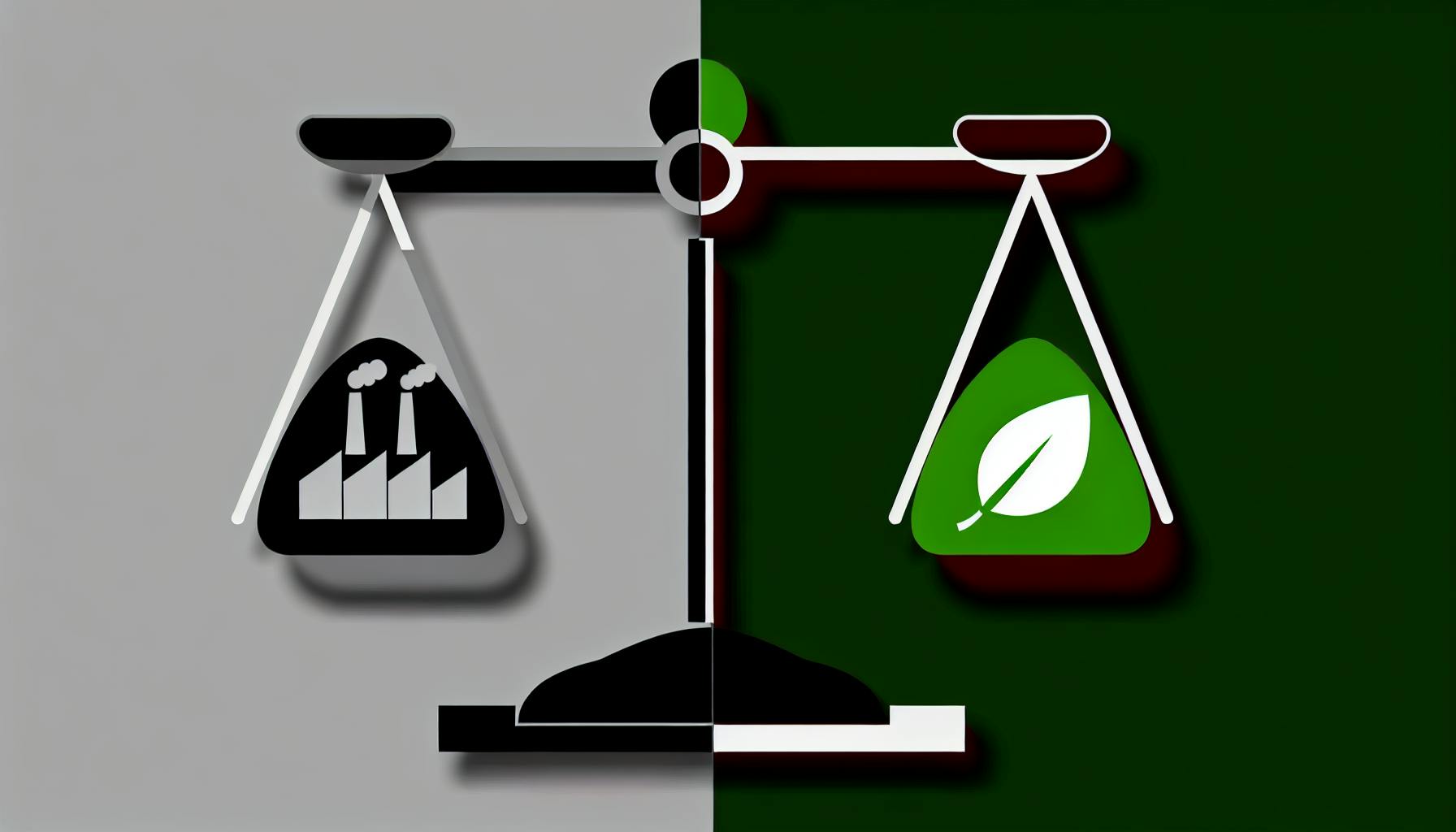Most SaaS companies would agree that effectively managing product life cycles can improve sustainability.
By considering sustainability at each stage of the product life cycle, SaaS companies can reduce their carbon footprint and strengthen their sustainability reporting.
This article outlines practical strategies to integrate sustainability across the key stages of the SaaS product life cycle, from inception to maturity. You'll learn how to conduct life cycle analyses and map a roadmap to meaningfully track and reduce emissions.
The Green Imperative in SaaS Product Life Cycles
SaaS product life cycles present unique opportunities for reducing environmental impact. By considering sustainability at each stage, SaaS providers can lower emissions and engage stakeholders.
Understanding the Product Life Cycle 5 Stages
The five key stages in a SaaS product's life cycle are:
- Introduction - when the product is first launched and adoption is low
- Growth - when usage and revenue expand rapidly
- Maturity - when growth plateaus and market saturates
- Decline - when usage and revenue decrease as the product ages
- Phase-out - when support ends and users migrate away
Applying sustainability principles during the introduction and growth stages allows maximum impact across the largest user base over time.
SaaS and Sustainability: A Strategic Overview
To reduce emissions through product life cycle management, SaaS firms can:
- Optimize code and infrastructure efficiency to minimize resource usage
- Transition to renewable energy to power cloud servers
- Prioritize recyclable and sustainably sourced hardware
- Offer customers carbon accounting tools and reports
- Publish annual sustainability reports for stakeholders
By taking a lifecycle view, SaaS companies can make their products and business models part of the sustainability solution.
What are the 5 stages of product life cycle?
The 5 key stages in a product's life cycle are:
- Development - This initial stage focuses on researching, designing, and building the product. Significant investments are made to create the product concept and make it market-ready.
- Introduction - The product is launched to the target market. Sales volume is low as customers learn about the new offering. Profits are typically negative or low.
- Growth - Sales increase rapidly as more customers adopt the product. Market share expands and profits start to rise.
- Maturity - Sales growth starts to slow as the market becomes saturated. Most potential customers already have the product. Profits level off or decline due to increased competition.
- Decline - Sales decline as even loyal customers begin switching to alternative or replacement products. The product is phased out or discontinued.
Understanding where a product lies along this life cycle trajectory allows SaaS companies to align their sustainability strategies accordingly. Tailoring carbon accounting, stakeholder communications, and emission reductions initiatives to the specific stage can optimize impact.
For example, during rapid scaling in the growth phase, calculating and offsetting increased cloud emissions is vital. Mature products reaching market saturation present opportunities to engage customers around end-of-life recycling programs.
Aligning sustainability efforts to the product life cycle allows SaaS companies to reduce emissions at scale while meeting stakeholder expectations.
What are the 4 stages of product life cycle and explanation?
The four key stages in a product's life cycle are:
- Introduction – This initial product launch phase focuses on building product awareness and trial. Businesses invest heavily in educating the market, while trying to drive customer acquisition. There may be substantial costs but low sales volumes during this early period.
- Growth – As the product gains traction, sales volumes start to increase significantly. More customers discover the product benefits, enhancing word-of-mouth promotion. Profitability begins rising too. Businesses still reinvest a share of revenue into further marketing at this phase.
- Maturity – Sales eventually peak and the product becomes widely established. Growth slows as markets approach saturation levels. The focus shifts from rapid expansion to defending market share. Marketing costs usually decline, supporting stronger profit margins.
- Decline - Sales decline as customer tastes evolve or new innovations emerge. Businesses may opt to milk the product for diminishing returns or strategically divest declining products to free up resources for other growth opportunities instead. Other exit route options can include selling or ceasing production.
Understanding these product life cycle phases assists businesses with planning appropriate strategies to support efficient resource allocation, while allowing them to capitalize on evolving market opportunities over time. Tracking life cycles also helps identify when products may become obsolete or require rejuvenation investments to drive renewed growth.
What are the 7 steps of product life cycle?
LET'S TAKE A LOOK AT THOSE STAGES IN A LITTLE MORE DETAIL.
Step 1: Ideation
Ideation is the first stage of the product life cycle where ideas for new products are generated based on market research and analysis. This involves identifying customer needs, analyzing competition, and brainstorming product ideas. Potential ideas are evaluated at this stage to select the best ones to take forward.
Step 2: Validation
The validation stage involves testing and validating the product idea with real customers. This usually takes the form of surveys, interviews, focus groups, or prototypes to assess market demand and willingness to pay. Validating early helps avoid wasting time on ideas that customers don't want.
Step 3: Prototyping
A prototype is created in this stage to demonstrate how the product will function. Prototypes can range from digital mockups to physical models. They allow gathering feedback on the product's design and features. Multiple design iterations take place based on user testing.
Step 4: Marketing
Product marketing efforts like market segmentation, positioning, and go-to-market strategy development happen in this stage. Marketing materials and sales collateral are created here to prepare for launch.
Step 5: Development
The validated product idea is turned into reality in the development stage. Engineering teams build software products. Manufacturers construct physical products. The final complete product is thoroughly tested at this stage.
Step 6: Launch
The finished product is introduced to the target market in the launch stage. This marks its official release for customers to purchase. Launch activities create awareness, drive adoption, educate buyers, and facilitate sales.
Step 7: Improvement
In this stage, customer feedback and product performance metrics are monitored to incrementally refine and enhance the product over time. These improvements aim to boost customer retention and satisfaction.
What is the product life cycle of theory?
The product life cycle theory describes the stages a product goes through from initial launch to final withdrawal from the market. Understanding this cycle can help businesses make better decisions around product development, marketing, and eventual sunset.
At its core, the product life cycle has four main stages:
- Introduction - This initial stage is when a product is first launched. Sales will be low as awareness of the product is still minimal. Marketing focuses on early adopters thought leaders to build interest.
- Growth - In this stage, sales accelerate as the product gains mainstream acceptance. Marketing shifts to focus on a broader audience to drive rapid growth.
- Maturity - Sales continue to grow but at a slower pace. The product now has wide market acceptance. At this stage companies look to improve the product and defend its market position.
- Decline - Sales begin to slow down and eventually decline as the product reaches market saturation or newer innovations enter to replace it. Marketing spend usually decreases and companies evaluate when to retire or replace the outdated product.
Understanding where a product stands in its life cycle informs key decisions around product, pricing, distribution, and promotional strategies. It allows companies to maximize opportunities in growth phases and proactively manage decline.
Integrating life cycle theory into product management, especially for SaaS companies targeting reduced emissions, results in more sustainable innovation cycles and less waste.
sbb-itb-919600f
The Inception: Beginning with Sustainability in Mind
Sustainability needs to be considered from the very first stages of product development in order to maximize positive environmental impact over the full life cycle.
Starting Sustainably: Introduction Stage of Product Life Cycle
The introduction phase represents the beginning of a product's life. This is when customer needs are evaluated and initial product designs and business plans take shape. For SaaS companies, sustainability should factor into decisions even at this early point. Some examples include:
- Conducting a life cycle assessment to model the product's impacts
- Prioritizing energy efficiency in coding and infrastructure
- Researching sustainable vendors and supply chains
- Setting environmental policies and goals
Building in sustainability from the start allows it to become part of a product's DNA rather than an afterthought. It also prevents having to retrofit features later, which takes more time and resources.
Design and Development: Setting the Green Foundation
The design and development stage is crucial for locking in sustainable attributes for the rest of the product life cycle. For SaaS products, developers have significant influence here. Some ways they can contribute include:
- Optimizing code for energy and resource efficiency
- Enabling renewable energy options for hosting infrastructure
- Implementing eco-friendly programming languages
- Creating digital tools to help users track and reduce emissions
Getting cross-functional teams aligned on sustainability goals also helps guide greener design choices. This early commitment to environmentally conscious development saves costs over time and builds vital credibility with eco-minded customers.
Rapid Expansion: SaaS Growth Stage and Carbon Considerations
As SaaS companies rapidly scale, they must balance growth with sustainability. The growth stage sees user acquisition accelerate, infrastructure expand, and operations intensify - all increasing environmental impact. However, by optimizing resources and minimizing waste, SaaS businesses can mitigate emissions even amidst expansion.
Growth Stage of Product Life Cycle: SaaS Scaling Up
The growth phase is marked by surging adoption and revenues. Server loads intensify to support more users as product capabilities expand. Marketing spends amplify to hasten acquisition. Teams balloon to manage proliferating customers. Supply chains strain under amplified materials demand.
Such breakneck growth risks sustainability unless ecosystems evolve responsibly. As SaaS solutions permeate mainstream markets, conscience necessitates curbing environmental footprints despite commercial priorities.
Sustainability Measures in the Face of Rapid SaaS Expansion
SaaS firms must incorporate sustainability within growth strategies by:
- Prioritizing renewable energy for cloud infrastructure as workloads surge. Migrating data centers to solar, wind or hydro-power abates emissions.
- Optimizing code and workflows for efficiency even as features multiply. Monitoring resource utilization, minimizing redundancy and streamlining processes conserve resources.
- Using sustainable materials despite accelerating hardware needs. Vetting component sourcing, product design and supply chain partners prevents waste.
- Engaging stakeholders throughout scaling. Embracing transparency and stewardship around sustainability issues enhances trust and loyalty.
Reconciling rapid growth with ecological balance requires companies uphold collective long-term interests despite profits-first mentalities. Sustainable expansion is paramount.
Sustaining Success: Maturity Stage Strategies for Emission Reduction
The maturity stage is when a product has established itself in the market. Growth starts to slow down as the market becomes saturated. For SaaS companies, this stage offers opportunities to optimize products for sustainability through continual improvement.
Navigating the Maturity Stage of Product Life Cycle in SaaS
The maturity stage can present sustainability challenges. As infrastructure expands to support customers, emissions may rise. Strategies like consolidation and efficiency can help stabilize a company's footprint.
For example, a SaaS firm could:
- Audit their cloud infrastructure usage and optimize server loads
- Transition to more renewable energy to power data centers
- Streamline code to reduce redundancies and inefficiencies
With planning and investment, SaaS products can continue satisfying customers while prioritizing eco-friendly practices. The key is taking a full lifecycle view to identify the ripest areas for footprint reductions.
Continual Improvement: SaaS Innovations for a Smaller Footprint
Mature SaaS firms should continually refine products to shrink emissions further. Some innovative ways to accomplish this include:
- Re-architecting software to require less computing resources. For example, using more efficient algorithms.
- Offering lightweight app versions for basic feature needs to reduce customer infrastructure demands.
- Integrating emissions tracking directly into SaaS administrative dashboards.
- Launching products like EcoHedge to help customers pinpoint their biggest digital carbon hotspots.
As stakeholders pressure tech companies to address sustainability, the maturity phase offers a chance to double down on emission-focused innovation. Tweaking architectures, optimizing code efficiency, and providing holistic insights can continually reduce SaaS carbon footprints.
Assessing Impact: Implementing Life Cycle Analysis in SaaS
Providing guidance on conducting life cycle analysis to quantify and mitigate the environmental impact throughout the SaaS product's life cycle.
The Essentials of Life Cycle Analysis for SaaS Products
Life cycle analysis (LCA) is a methodology used to evaluate the environmental impact of a product throughout its life cycle stages. For SaaS providers, understanding the impact of your digital products can be complex but critical for sustainability efforts.
Conducting a LCA allows SaaS companies to:
- Identify high-impact life cycle stages of their products
- Quantify environmental impacts like carbon emissions
- Pinpoint areas for improvement across product design, infrastructure, and operations
Key aspects of LCAs for SaaS include assessing:
- Raw material extraction and hardware manufacturing
- Data center electricity usage from cloud infrastructure
- Transportation related to equipment delivery and business travel
- Product maintenance, updates, and end-of-life
By taking a detailed view of impacts across the full product system over time, SaaS providers can make informed decisions to reduce footprints.
Practical Steps for Conducting LCA in SaaS
Effectively implementing LCA for a SaaS product involves:
- Defining goals and scope - Determine the motivation for conducting LCA, key impacts to analyze (e.g. carbon emissions), system boundaries, and assumptions.
- Collecting data - Gather details on materials, energy use, transportation, and processes across the product's lifecycle through methods like surveys, metering, and financial reports.
- Evaluating impacts - Identify hotspots, calculate total footprints, and compare scenarios using LCA data processed by lifecycle analysis software.
- Interpreting and sharing results - Pinpoint reduction opportunities, create strategies, integrate findings into sustainability reports, and communicate achievements.
- Continual improvement - Re-evaluate periodically to determine progress made on lowering environmental footprints as changes are implemented.
Regular LCA provides actionable insights, allowing SaaS companies to create leaner, cleaner products while demonstrating leadership. By understanding true lifecycle impacts, the path to net-zero emissions comes into focus.
Conclusion: Integrating Product Life Cycle and Sustainability
Sustainability must be considered at all stages of the product life cycle in SaaS. By taking a holistic, lifecycle approach, SaaS companies can reduce emissions, minimize waste, and engage stakeholders more effectively.
Recap: Key Sustainability Lessons Across Product Life Cycle Stages
- Introduction stage: Conduct a sustainability assessment to understand environmental impacts from the outset. Set emissions baselines.
- Growth stage: Optimize energy and resource efficiency in product design and infrastructure scaling. Prioritize renewables.
- Maturity stage: Engage customers on sustainability. Explore circular business models to extend product lifetime.
- Decline stage: Responsibly retire infrastructure and recycle components. Offer trade-in and upgrade incentives.
Strategic Sustainability: A Roadmap for SaaS Companies
To embed sustainability across the SaaS product lifecycle:
- Assign executive oversight and set public goals
- Continuously monitor and report footprint
- Seek certified carbon neutrality
- Prioritize energy efficiency in software and infrastructure
- Engage stakeholders through transparency and education
Taking a lifecycle approach strengthens the business case for sustainability and positions SaaS companies as responsible, forward-thinking players in the net zero transition.



